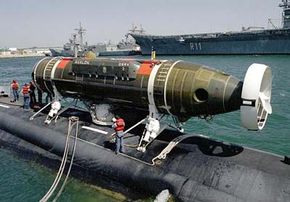Rescue
When a submarine goes down because of a collision with something (such as another vessel, canyon wall or mine) or an onboard explosion, the crew will radio a distress call or launch a buoy that will transmit a distress call and the submarine's location. Depending upon the circumstances of the disaster, the nuclear reactors will shut down and the submarine may be on battery power alone.
If this is the case, then the crew of the submarine have four primary dangers facing them:
Advertisement
- Flooding of the submarine must be contained and minimized.
- Oxygen use must be minimized so that the available oxygen supply can hold out long enough for possible rescue attempts.
- Carbon dioxide levels will rise and could produce dangerous, toxic effects.
- If the batteries run out, then the heating systems will fail and the temperature of the submarine will fall.
Rescue attempts from the surface must occur quickly, usually within 48 hours of the accident. Attempts will typically involve trying to get some type of rescue vehicle down to remove the crew, or to attach some type of device to raise the submarine from the sea floor. Rescue vehicles include mini-submarines called Deep-Submergence Rescue Vehicles (DSRV) and diving bells.
The DSRV can travel independently to the downed submarine, latch onto the submarine over a hatch (escape trunk), create an airtight seal so that the hatch can be opened, and load up to 24 crew members. A diving bell is typically lowered from a support ship down to the submarine, where a similar operation occurs.
To raise the submarine, typically after the crew has been extracted, pontoons may be placed around the submarine and inflated to float it to the surface. Important factors in the success of a rescue operation include the depth of the downed submarine, the terrain of the sea floor, the currents in the vicinity of the downed submarine, the angle of the submarine, and the sea and weather conditions at the surface.
Related HowStuffWorks Articles
More Great Links
- See Inside a Submarine
- Drive the Virtual Submarine
- Russia's (USSR) Arms Catalog: Project 949 Oscar-I/II class
- National Geographic: K-3 "Leninsky Komsomol"
- Russian Northern Fleet
